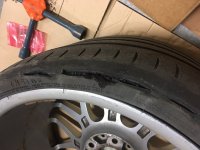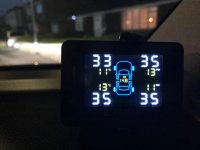Just a quick reminder to everyone to check your tyre pressures on a regular bases and NOT rely on the tyre pressure monitor on the E85 / 86. Long story short - hadn't checked mine with a gauge for 3 months or so, and just gave them a casual visual as I approached the car - all looked OK. Handling felt fine.
Driving home from work which luckily is only a few miles when suddenly the TPS light comes on. Pulled the car over and did a quick visual on all the tyres (in the dark). The rear right looked a little bit low but certainly not flat. So, got compressor out of boot and attempted to top it up...nadda...couldn't get any air into it at all, gauge on compressor read 0psi. Odd I thought. Made the conclusion it must be the valve that was faulty and completed the remaining 1 mile journey home at a snails pace with the hazards on.
Note these are 265/30/R19 non-runflat Goodyear Eagle F1.
Got it in the garage when arrived home and took the wheel off.... This is what I found



So basically wrecked!!! Went around and checked the pressures on all other tyres:
RL - 32psi
RR - 0psi (obviously)!
FL - 16psi
FR - 25psi
I may have been driving around for weeks like this and the TPS did not flag it.
Lessons learned:
1) The profile and sidewall on the Eagle F1's is such that even at 0psi the tyres don't appear completely flat. You can even drive on them to some degree (as I did)! Don't rely on a visual check!!!!
2) The TPS on the E85 is not very good!
3) It's cheaper to regularly check your tyre pressures than have to shell out £300 for a new pair!
4) Get your alignment checked (you can see the inside edge of the tyre is much more worn than the outside).
Driving home from work which luckily is only a few miles when suddenly the TPS light comes on. Pulled the car over and did a quick visual on all the tyres (in the dark). The rear right looked a little bit low but certainly not flat. So, got compressor out of boot and attempted to top it up...nadda...couldn't get any air into it at all, gauge on compressor read 0psi. Odd I thought. Made the conclusion it must be the valve that was faulty and completed the remaining 1 mile journey home at a snails pace with the hazards on.
Note these are 265/30/R19 non-runflat Goodyear Eagle F1.
Got it in the garage when arrived home and took the wheel off.... This is what I found

So basically wrecked!!! Went around and checked the pressures on all other tyres:
RL - 32psi
RR - 0psi (obviously)!
FL - 16psi
FR - 25psi
I may have been driving around for weeks like this and the TPS did not flag it.
Lessons learned:
1) The profile and sidewall on the Eagle F1's is such that even at 0psi the tyres don't appear completely flat. You can even drive on them to some degree (as I did)! Don't rely on a visual check!!!!
2) The TPS on the E85 is not very good!
3) It's cheaper to regularly check your tyre pressures than have to shell out £300 for a new pair!
4) Get your alignment checked (you can see the inside edge of the tyre is much more worn than the outside).


